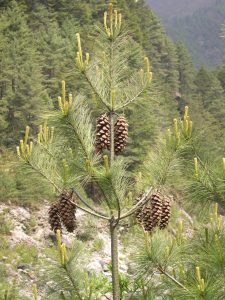The Himalayan pine used to treat broken bones

Pinus wallichiana, which is also known as the Himalayan Pine, grows in temperate forests of mixed species between 1300 to 4100m altitude. It favours habitat with lower rainfall (dry valleys) and is often found growing with Chir pine (Pinus roxburghii). At first sight these two pines can look similar, but you can easily tell them apart as the Himalayan pine has bundles of five needle-like leaves, whereas Chir pine has needles in bundles of threes.
The timber is used commercially and its resin is a source of turpentine and tar. The resin is used to make a cast to stabilise broken bones, and it is used as an antiseptic and balm to relieve pain. The resin and fragrant wood are both burned as incense.
Amongst the many chemicals found in the resin are the terpenes. When they are washed from the needles by rain they inhibit seeds from germinating. As a result, only few plants can establish in pine forest, so the understorey is sparse and the ground is carpeted in a thick layer of slowly decomposing pine needles.
